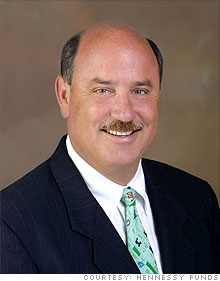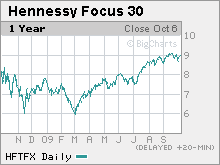How to be an emotionless investor
Neil Hennessy has used a numbers strategy to consistently beat the S&P 500 for years. Here's what he likes now.
 |
| Hennessy on Japan: "This is so ugly that you have to buy into it." |

NEW YORK (Fortune) -- It's one of the truths of mutual fund investing: You buy the manager as much as the prospectus. So it pays to have someone you trust.
Neil Hennessy, who runs the Hennessy Focus 30 fund (HFTFX), might be someone investors trust for what he does as much as what he doesn't do. Since its September 2003 launch, the Focus 30 has returned 6.76% annually, beating the S&P 500 by an average of 4.8% a year by following a simple, quantitative strategy. Hennessy only reshuffles the fund's 30 stocks once a year, usually in the fall. That means two things: He can't time the market and he can't let feelings get in the way.
After writing about his flagship fund back in February, we recently checked in with Hennessy. He had just finished rebalancing the Focus 30 in September, which meant screening 10,000 companies to find mid-cap U.S. securities that pass his requirements for price-to-sales ratio, increased annual earnings, and recent rallies. If a company makes it to the top 30, it's given equal weight: Each stock makes up 3.33% of the fund.
Last year consumer discretionary stocks composed a third of the portfolio. That led to a paltry 0.7% gain for the portfolio in the past year, but it still beats the S&P 500's (SPX) 5% drop.
This year, consumer discretionary stocks again make up a third of the portfolio. Included are recognizable names like discount retailers Ross Stores (ROST, Fortune 500) and Dollar Tree (DLTR, Fortune 500). "The theme of `more for less' is starting to move the other sectors of our economy," says Hennessy. "People have switched their buying habits and they're not going the other way."
Tupperware Brands (TUP), the reusable packaging maker, is one of the fund's new holdings. Auto parts chain O'Reilly Automotive (ORLY) is another. As is Ball Corp. (BLL, Fortune 500), which makes cans for vegetables and other packaged-food. Hennessy also likes Carter's (CRI), which makes and sells children's clothes under the Carter's and OshKosh brands at Target (TGT, Fortune 500) and Wal-Mart (WMT, Fortune 500) stores.
The loss of two utilities, Piedmont Natural Gas Company (PNY) and Hawaiian Electric Industries (HE), from the fund reflects Hennessy's belief that consumers are scaling back on spending. He thinks utilities will suffer as Americans turn thriftier -- for example, turning off the lights or not heating the hot tub.
This year, Hennessy's emotion-free strategy led him to Japanese stocks. If you don't believe it takes a dispassionate investor to enter Japan, consider a chart Hennessy likes to show that illustrates the Nikkei 225 index's 82% decline from its peak in December 1989 to October 2008.
"This is so ugly that you have to buy into it," he says.
Hennessy likes that 126 million Japanese have $13 trillion in bank deposits: "That's a lot of cash, and only 12% is in equities." An aging population is transferring wealth to a younger generation that is more prone to take risk in stocks, Hennessy says.
He also notes that 32% of Japanese exports go to emerging markets. "Look at Asia, especially China: As they continue to get a middle class, they're going to want a Sony TV or a Lexus."
Hennessy likes Japan so much that he visited Tokyo for the first time this summer and bought two Japanese funds run by Shu Abe, one of the largest hedge fund mangers in Asia.
Abe grew SPARX Asset Management into Tokyo's largest hedge fund in the past twenty years, but his two U.S.-listed funds failed to entice American investors wary of Japan's two-decade bear market. The funds, renamed the Hennessy Select SPARX Japan Fund (SPXJX) and Hennessy Select SPARX Japan Smaller Companies Fund (SPJSX), will be sub-advised by Abe.
"What are you going to lose in Japan?" Hennessey asks. "The downside risk is [already] here."
For investors still leery of a Japanese stock market resurgence, Hennessy stands behind U.S. stocks. "People think I'm crazy," he says, but after companies laid off record numbers of employees and closed non-profitable businesses, he thinks the Dow Jones industrial average will return to historical levels of 8% to 12% annual growth for the next decade.
"The good news is that there's no confidence out there," he says. "The real good news is that there's a lot of money on the sidelines. I think we're in for a sustained rally." ![]()
-
 The retail giant tops the Fortune 500 for the second year in a row. Who else made the list? More
The retail giant tops the Fortune 500 for the second year in a row. Who else made the list? More -
 This group of companies is all about social networking to connect with their customers. More
This group of companies is all about social networking to connect with their customers. More -
 The fight over the cholesterol medication is keeping a generic version from hitting the market. More
The fight over the cholesterol medication is keeping a generic version from hitting the market. More -
 Bin Laden may be dead, but the terrorist group he led doesn't need his money. More
Bin Laden may be dead, but the terrorist group he led doesn't need his money. More -
 U.S. real estate might be a mess, but in other parts of the world, home prices are jumping. More
U.S. real estate might be a mess, but in other parts of the world, home prices are jumping. More -
 Libya's output is a fraction of global production, but it's crucial to the nation's economy. More
Libya's output is a fraction of global production, but it's crucial to the nation's economy. More -
 Once rates start to rise, things could get ugly fast for our neighbors to the north. More
Once rates start to rise, things could get ugly fast for our neighbors to the north. More







